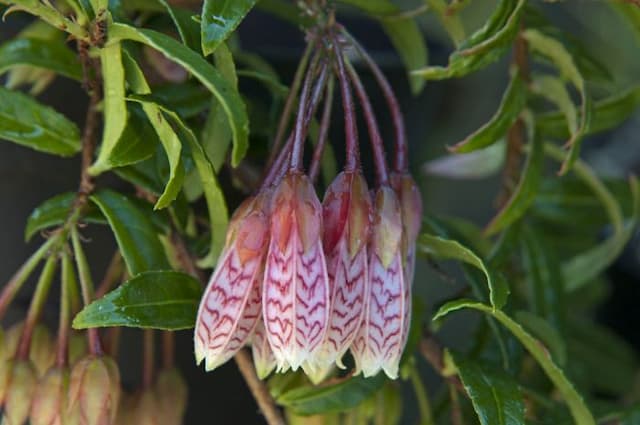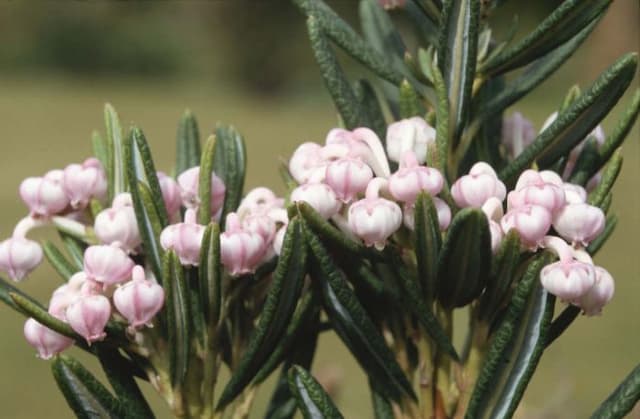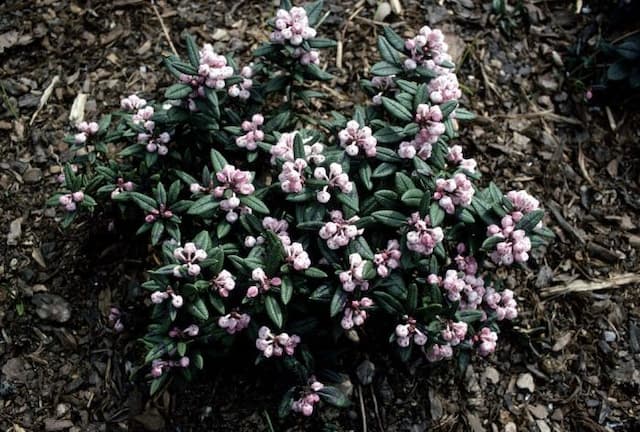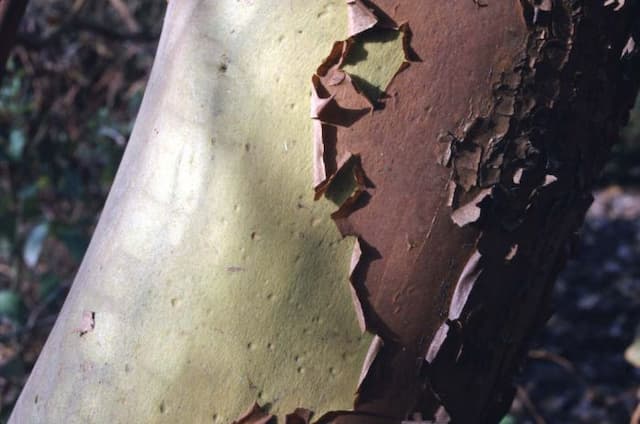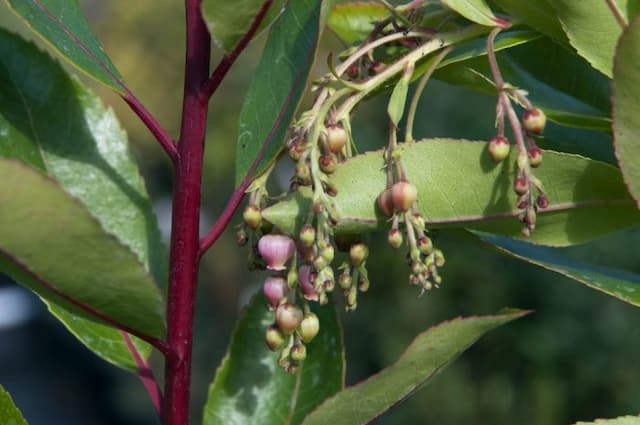Japanese Andromeda Pieris japonica 'Blush'
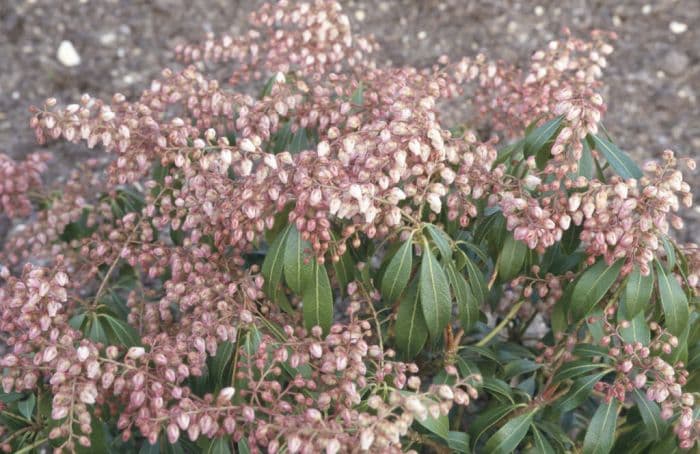
ABOUT
Pieris japonica 'Blush', commonly known as the Japanese Andromeda 'Blush', is a decorative evergreen shrub with a distinct appearance. The plant boasts glossy, deep green leaves that provide a rich backdrop for its striking floral display. The young foliage often emerges with a reddish or bronze tint, adding a colorful blush to the plant's palette, which is where the cultivar 'Blush' gets its name. The show-stopping feature of this cultivar is its beautiful clusters of bell-shaped flowers. These flowers typically have a delicate pinkish hue, and they hang elegantly in pendulous chains resembling lily-of-the-valley, offering a soft contrasting burst of color against the darker foliage. The blooms emerge in late winter to early spring, bringing a welcome splash of color to gardens at a time when many plants have yet to awaken from dormancy. In addition to its beautiful foliage and flowers, the Japanese Andromeda 'Blush' may also display attractive seed capsules that further add to its ornamental value. The textured leaves and the overall shape of the plant create an appealing structure that provides year-round visual interest, making it a favored choice for gardeners looking to enhance their landscapes with a touch of elegance.
About this plant
 Names
NamesFamily
Ericaceae.
Synonyms
Japanese Andromeda, Japanese Pieris, Lily-of-the-Valley Bush, Andromeda, Fetterbush.
Common names
Pieris japonica 'Blush'.
 Toxicity
ToxicityTo humans
The Japanese Andromeda is poisonous to humans if ingested. All parts of the plant contain grayanotoxins, which can cause symptoms such as vomiting, diarrhea, abdominal pain, and in severe cases, cardiovascular problems like low blood pressure and cardiac arrhythmias. Ingesting its parts, especially in larger amounts, can lead to potentially serious consequences and medical attention should be sought if poisoning is suspected.
To pets
The Japanese Andromeda is toxic to pets, including cats, dogs, and horses. Similar to its effects on humans, the plant contains grayanotoxins. If pets consume any part of the plant, they may display symptoms like vomiting, diarrhea, drooling, weakness, and in severe cases, low blood pressure, tremors, seizures, and cardiac issues. It is important to prevent pets from ingesting this plant and to seek veterinary care immediately if exposure is suspected.
 Characteristics
CharacteristicsLife cycle
Perennials
Foliage type
Evergreen
Color of leaves
Green
Flower color
Pink
Height
4-6 feet (1.2-1.8 meters)
Spread
2-4 feet (0.6-1.2 meters)
Plant type
Shrub
Hardiness zones
5-8
Native area
Japan
Benefits
 General Benefits
General Benefits- Attractive Foliage: Pieris japonica 'Blush' has evergreen leaves that provide year-round interest and color in the garden.
- Early Spring Flowers: It produces clusters of pinkish-white flowers in the early spring, adding vibrancy after the winter season.
- Low Maintenance: Once established, it requires minimal care, making it a good choice for gardeners with limited time.
- Drought Tolerant: It can withstand periods of dryness once fully established, reducing the need for frequent watering.
- Shade Tolerant: Thrives even in partially shaded conditions where other plants might struggle to grow.
- Attracts Pollinators: The early spring flowers of Pieris japonica 'Blush' are attractive to bees and other pollinators, providing an early food source.
- Deer Resistant: The foliage and flowers are not typically favored by deer, making it a good choice in areas where deer browsing is an issue.
- Compact Size: Its growth habit is relatively compact, making it suitable for small gardens or as part of a mixed border.
- Architectural Structure: With its upright form, it can add structure and elegance to garden designs.
- Versatility: It can be used for a variety of landscaping purposes, such as foundation plantings, borders, or woodland gardens.
 Medical Properties
Medical PropertiesThis plant is not used for medical purposes.
 Air-purifying Qualities
Air-purifying QualitiesThis plant is not specifically known for air purifying qualities.
 Other Uses
Other Uses- Pieris japonica 'Blush' can be used in bonsai cultivation. The plant's compact growth habit and attractive foliage make it suitable for this intricate and traditional Japanese art form.
- This plant can serve as an educational tool in botany classes to illustrate plant taxonomy and diversity due to its unique characteristics among the Ericaceae family.
- Pieris japonica 'Blush' can be planted in memorial gardens where its year-round beauty offers remembrance and a sense of peace for loved ones.
- The shrub can be used in photography and film as a backdrop for spring scenes because of its appealing early season blossoms.
- It can be used as a natural dye source; the flowers, leaves, and bark may yield varying shades of colors for fabrics and crafts.
- This variety can play a role in ecological studies by providing an example of a plant that may respond to changing climatic conditions, due to its specific habitat preferences.
- It can serve as a host plant for certain butterfly and moth species, thereby playing a part in local biodiversity conservation efforts.
- In urban landscaping, Pieris japonica 'Blush' can be used to create privacy screens or green walls that help dampen city noise and create tranquil green spaces.
- The plant is sometimes utilized in the creation of thematic gardens, such as Asian-inspired or woodland settings, providing the right aesthetic for these landscapes.
- Pieris japonica 'Blush' can be used in container gardens on balconies or patios, where its evergreen foliage adds beauty and structure throughout the year.
Interesting Facts
 Feng Shui
Feng ShuiThe Japanese Andromeda is not used in Feng Shui practice.
 Zodiac Sign Compitability
Zodiac Sign CompitabilityThe Japanese Andromeda is not used in astrology practice.
 Plant Symbolism
Plant Symbolism- New Beginnings: Commonly known as Japanese Andromeda, Pieris japonica 'Blush' is a plant that blossoms in early spring. This can symbolize new beginnings or starting afresh as it is one of the first plants to announce the end of winter and arrival of spring.
- Cleansing: The white or pinkish flowers of the Japanese Andromeda can also represent purity and cleansing. This symbolism comes from the bright, fresh appearance of the blooms which can be associated with clearness and cleanliness.
- Protection: In some cultures, Pieris japonica is believed to ward off evil. Its part in traditional gardens may be tied not just to aesthetics but to a symbolic role in protecting the home from negative influences.
- Eternal Beauty: As an evergreen shrub, the Japanese Andromeda is often associated with eternal beauty, because it maintains its glossy green leaves throughout the year, regardless of the season, suggesting enduring or timeless attractiveness.
 Water
WaterThe Japanese Andromeda 'Blush' requires consistent moisture, so it should be watered deeply once a week, ensuring that the soil is moist but not soggy. During hot and dry periods, this may increase to twice a week. It's advisable to provide about a gallon of water for each watering session to adequately saturate the root zone. Reduce watering in the winter months when the plant's growth slows down. Always check the top inch of soil for dryness before watering to avoid overwatering which can lead to root rot.
 Light
LightJapanese Andromeda 'Blush' thrives in partial shade, preferring a spot that gets dappled sunlight. It's best positioned to receive morning light, which is gentler, with protection from the harsh afternoon sun. An ideal placement would be under the canopy of larger trees where it can receive filtered sunlight throughout the day, mimicking its natural habitat in forest understories.
 Temperature
TemperatureJapanese Andromeda 'Blush' prefers temperate climates and grows best in temperatures ranging from 60°F to 75°F. It can tolerate a minimum temperature down to about 0°F and maximum temperatures up to around 90°F. However, prolonged exposure to temperatures outside of its ideal range, particularly extreme heat, can stress the plant.
 Pruning
PruningJapanese Andromeda 'Blush' should be pruned to maintain its shape and remove any dead or diseased branches. The best time for pruning is after the plant has finished blooming in spring to avoid cutting off next year's flower buds. It generally requires pruning once a year, but light trimming can be done as needed throughout the year to keep the plant tidy.
 Cleaning
CleaningAs needed
 Soil
SoilFor Japanese Andromeda 'Blush', use an acidic soil mix with a pH between 4.5 and 6. A blend consisting of peat moss, pine bark, and perlite or sand can create a well-draining, moisture-retentive environment that this plant prefers.
 Repotting
RepottingJapanese Andromeda 'Blush' should be repotted every 2 to 3 years or when it becomes root-bound to ensure continued health and growth.
 Humidity & Misting
Humidity & MistingJapanese Andromeda 'Blush' thrives in moderate to high humidity levels but can tolerate average household humidity.
 Suitable locations
Suitable locationsIndoor
Place Japanese Andromeda 'Blush' in bright, indirect light.
Outdoor
Plant in partial shade, protect from harsh sun.
Hardiness zone
5-8 USDA
 Life cycle
Life cycleThe Japanese andromeda 'Blush', a cultivated variety of Pieris japonica, begins its life cycle as a seed, which germinates in moist, well-draining soil with partial to full shade exposure. After sprouting, it progresses into a young seedling with characteristic foliage and requires adequate water and protection from harsh conditions to establish its root system. As it matures, it develops into a flowering shrub, typically reaching 9-12 feet in height and 6-8 feet in width, and in early spring it produces clusters of pink-tinged white flowers that attract pollinators. Post-flowering, it sets seed in the form of small capsules that, once mature, release seeds to propagate the next generation. Throughout its perennial life, the plant goes through cycles of growth and dormancy, with foliage ranging from vibrant red to deep green, requiring regular maintenance such as pruning to manage shape and health. Upon reaching the end of its lifespan, which can be several decades under optimal conditions, it gradually declines and eventually dies, completing its life cycle.
 Propogation
PropogationPropogation time
Early spring
The most popular method of propagation for Pieris japonica 'Blush', commonly known as Japanese pieris or Lily-of-the-Valley shrub, is through semi-hardwood cuttings. This typically takes place in late summer or early fall when the plant's new growth has begun to mature but is not yet fully hardened. To do this, a cutting approximately 4 to 6 inches (10 to 15 centimeters) long is taken, with several leaves left at the top and the bottom portion stripped of leaves. The cut end is then dipped in rooting hormone to encourage root development and placed in a well-draining potting mix. The cutting should be kept moist and in indirect light until roots have developed, which usually takes several weeks. After the cuttings have established a robust root system, they can be transferred to larger pots or directly to an appropriate spot in the garden.
